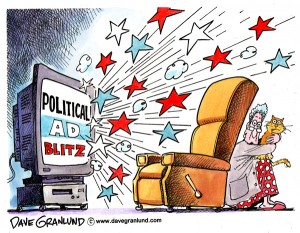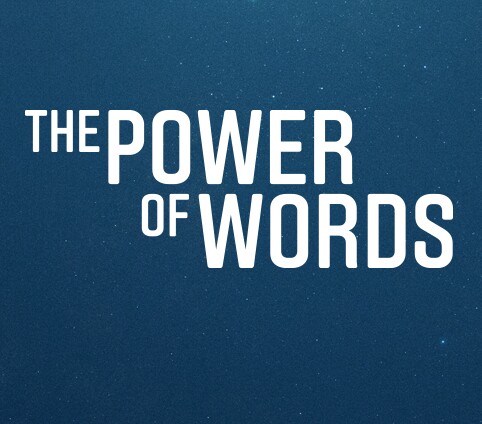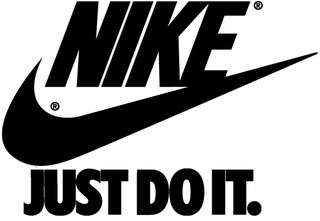Rolf Gutknecht is vice president, director of account services for LA ads. To discuss your thoughts with Rolf on this blog or any marketing matters, email via this link, or visit www.LAadsMarketing.com. You can also connect with Rolf on LinkedIn.
 I’m so glad it’s over. Probably like you, my home phone was being called at an increasing rate the closer that we got to Election Day. Candidates’ faces and names were everywhere and on everything from direct mail to lawn signs and outdoor boards to TV and radio commercials. As annoying as it was, there were a number of messaging strategies and tactics that caught my attention because they were executed exceedingly well, which, as marketers, we should consider adding to our communication toolkits for use tomorrow, next week or next month. For as we all know, your customer and prospects are still being bombarded with marketing messages each and every day by both you and your competitors.
I’m so glad it’s over. Probably like you, my home phone was being called at an increasing rate the closer that we got to Election Day. Candidates’ faces and names were everywhere and on everything from direct mail to lawn signs and outdoor boards to TV and radio commercials. As annoying as it was, there were a number of messaging strategies and tactics that caught my attention because they were executed exceedingly well, which, as marketers, we should consider adding to our communication toolkits for use tomorrow, next week or next month. For as we all know, your customer and prospects are still being bombarded with marketing messages each and every day by both you and your competitors.
So let me share with you some strategies and tactics used by politicians leading up to November 8th that are worth remembering today.
1) Understand the takeaway
Truth is, these folks do have some things to teach us marketers, particularly regarding messaging. They see the world a bit differently than we do, and use techniques most people didn’t learn in school or on the job, such as: It’s Not What You Say, It’s What People Hear. You can have the best message in the world, but the person on the receiving end will always understand it through the prism of his or her own emotions, preconceptions, prejudices, and existing beliefs. We focus too much of our energy on finding the best way to sell our message, and too little on understanding the filters consumers have as we deliver it. Political marketers care more about takeaways than inputs.
2) Make it look good
Did you see the biographic videos produced by the two Presidential candidates? They were extraordinarily well done. A number of other political ads were also well done from a storytelling and video perspective. They stayed on message concentrating on the one critical point (not 4 or 5 points) that they wanted to make sure was communicated. The videos were shot and narrated well. They didn’t hire amateurs to do their work but had expert writers and producers creating the content. Like with your business, there’s too much at stake to do cheap stuff because everyone knows what cheap means. People interpret what your company or brand stands for based on the quality of creative and the media channel it’s presented on. Don’t go out until you look good.
3) Be the genuine article
Business marketing sometimes seems to stretch the truth a bit too much. When marketing messages are sufficiently visible and sufficiently wrong, the press will get wind and call you on the truth of your marketing. Transparency of your brand could never be more important. It is less about giving the appearance of perfection and more about being genuine and human as we build relationships. While it’s critically important to craft your story and advocate for the benefits of your product or service, it’s not fine to lie about them. My mom use to tell me “Lies have short legs,” meaning you can’t outrun the truth …so don’t stretch.
4) You are who you say you are
In the world of politics, I would argue that there’s nothing as important as branding and having people recognize what the brand stands for. Brand consistency is always maintained. Unlike politicians, too many companies struggle with this, swinging wildly from one branding concept to another. In political ads, everything from the taglines to the logos to the visuals has been choreographed beautifully. Get your branding figured out right now. Here are a few questions to ask yourself to determine if your branding is clear:
5) Be social…not antisocial
Politicians don’t just post stuff to their respective Twitter or Facebook accounts and hope people will read it. Rather, they actually engage with their social media audience. They post images and video. They have their immediate families and supporters use social media regularly. How is your company using social media to spread the good word about your company? I’ll be the first to say that spending a lot of time, money and resources on social media is not right for every company, maybe not even yours, but without some presence, you’re letting the competition become more visible and be seen as a legitimate business partner at your expense.
6) Tell the story again and again
Why are most political ads annoying? Some of it is the content, but I think most of the annoyance is the sheer quantity of political advertising as elections draw near. But politicians know one thing: without a communications budget that allows you to be out in the market in a way that shows you’re a player, you won’t get the job done. Far too many companies who do “invisible marketing” base their companies short and long term success on thinking that customers will pick them over a brand that’s actively marketing and better known. The takeaway is that repetition is key …but too much repetition annoys.
As I said earlier, I’m glad the madness of the political advertising season is over. But I’m grateful to have observed it from a marketer’s perspective, because it’s a reminder that each and every day customers and prospects are voting who they want to do business with. Let the winner be you.
# # # #
Rolf Gutknecht is vice president, director of account services for LA ads. To discuss your thoughts with Rolf on this blog or any marketing matters, email via this link, or visit www.LAadsMarketing.com. You can also connect with Rolf on LinkedIn.
 Fulfillment isn’t always what it’s cracked up to be, especially in business. Consider a conversation I had today with one of our media reps that revealed why so many B2B ads aren’t just bland but simply bad. This was in response to why an ad appeared in their publication quite differently from what the advertiser expected. (We didn’t do this ad, so we’re off the hook!) When we asked the rep why the ad didn’t fit the space properly, and why the publication didn’t contact the advertiser to discuss the problem, the answer was they’re so used to getting poorly-designed ads, they’ve just come to accept what they’re sent without question.
Fulfillment isn’t always what it’s cracked up to be, especially in business. Consider a conversation I had today with one of our media reps that revealed why so many B2B ads aren’t just bland but simply bad. This was in response to why an ad appeared in their publication quite differently from what the advertiser expected. (We didn’t do this ad, so we’re off the hook!) When we asked the rep why the ad didn’t fit the space properly, and why the publication didn’t contact the advertiser to discuss the problem, the answer was they’re so used to getting poorly-designed ads, they’ve just come to accept what they’re sent without question.
How shocking this answer was to us! And yet, it so perfectly identifies the state of things across many of the industries in which we work.
The real problem is that in the last several decades, the role of marketing has been relegated to fulfilling. In other words, it seems the task these days is to “get the ad into the pub,” and not worry about whether the ad is great and shifts the attention of the audience. Advertisements, websites, collateral and all other marketing communications are less effective today it seems because they’re just space-fillers. The media plan says they have to be there. So the result is lots of media space or air time taken up with ad messages that aren’t merely forgettable but are also not produced or placed that well.
So it’s time for anyone who is responsible for advertising and marketing to look in the mirror and ask, “Am I a fulfiller or a marketer? Is marketing a task to be checked off on my list of the day’s activities or do I delight in the prospect of arriving at a plan so smart and unexpected, it makes me giggle?” Fulfillment is great in the abstract, but a killer in business.
I’ve often said that marketing is a self-fulfilling prophesy: if you believe it works, you’ll invest yourself and your resources into it fully and – Voilà!- it works; or if you doubt its effectiveness, you’ll put in the minimal efforts (in other words, simply fulfill the order) without great enthusiasm and you’ll also be proven right.
Every piece of communication from your desktop is an opportunity to invigorate sales and renew a conversation with your customer…if you believe it will.
It means, in some cases, looking at the internal team who are engaged in your marketing. Are they people who majored in advertising and marketing in school, and are they still “students” of it today? Or did they move across from the HR or accounting department because nobody else wanted the job? Are they fully invested employing great marketing to grow your operation, or are they also juggling bookkeeping, sales, IT and family services all at the same time? Are you taking full advantage of outside resources who aren’t just design shops and web programmers but genuine marketing specialists, who will challenge and surprise you and are willing to own up to the results?
In other words, at the bottom line, is marketing a joy…or is it a job?
Think carefully about how you answer this. Because your company’s success hangs in the balance.
####
Rolf Gutknecht is vice president, director of account services for LA ads. To discuss your thoughts with Rolf on this blog or any marketing matters, email via this link, or visit www.LAadsMarketing.com. You can also connect with Rolf on LinkedIn.
First, a cork-popping congratulations to the Broncos, and condolences to all the Panthers fans. Now comes the Monday-morning quarterbacking and all the after-game analyses, almost as much fun as following this year’s election season!
But personally, I think the big winner in the game was Kia Motors, whose “Walken Closet” commercial was one of the truly great moments in Super Bowl advertising. Feel free to click here to watch the spot and then come right back for the play-by-play.
Welcome back!
For a commercial – or any advertising, for that matter – to be effective, it has to accomplish several critical feats: It has to break through and attract attention, it has to be clear in its fundamental selling message, the message has to be compelling, and it has to be memorable when you walk away from it.
I’ve argued for years that most Super Bowl commercials only accomplish the first and last requirements. You watch and enjoy them, you may laugh at their gags and you talk about them after the game. But on the selling-side, most hardly make it past the scrimmage line. They don’t leave you wanting to know more about the product or even “get” the product’s unique selling proposition (USP), the thing that makes the product unique among its competitors. That surely can’t be said of the Kia spot.
First off, who can’t be drawn into Christopher Walken’s creepily intense performance no matter what he does? And the gag about the “Walken closet” is hilarious. But when Walken metaphorically compares most mid-sized sedans to uninspired beige socks and the Optima to the “world’s most exciting pair of socks,” in a way only he can deliver, he absolutely nails the Optima’s unique selling proposition: a car with “pizzazzzzz” in a world of otherwise boring mid-sized competitors. If you’re thinking about buying a mid-size after watching this commercial, you’re compelled to at least check out the Optima. (After all, who wants to be boring and beige?)
Our lives are way too busy for us to be attracted to “beige” things. Yet, too many marketers don’t project that same line of thinking toward attracting customers. Decisions are made daily to keep producing and running the same run-of-the-mill, uninspiring stuff…week after week, year after year.
Keep in mind that when you as a consumer see anything from a company, either your opinion of that company is enhanced or it’s not. There’s no middle ground. You either like them a bit more or you go in the other direction. So why do so many marketers turn that compelling, money-making value proposition into a beige and uninteresting “me-too” message that each and every one of their competitors could say.
I don’t know about you, but I’ve never been bored into buying anything. And I’m even going to say that 99% of your customers are with me on this. The marketing you do for your company should be an extension of you. You’re the person who’s responsible for communicating the passion of your company. When you talk about your business with others, hopefully your eyes twinkle, your heart begins to race, your voice becomes more dynamic and people are instantly attracted to you. When that show of enthusiasm and excitement happens, no one would confuse you with being boring, right? Of course not. So look at your marketing and see if it reflects that same level of specialness. (Or you could always ask friends, colleagues or suppliers who will be candid with you, “Does this marketing make you want to pick up the phone or know more about us?” If the answer is not an enthusiastic “yes,” then it’s time to start over.)
In a world of “beige” mid-size sedans, there’s the Kia Optima. In your competitive world where there’s so much beigeness, where do you stand? C’mon, punch it!
####
Rolf Gutknecht is vice president, director of account services for LA ads. To discuss your thoughts with Rolf on this blog or any marketing matters, email via this link, or visit www.LAadsMarketing.com. You can also connect with Rolf on LinkedIn.
 This is not a post about what headlines work better than others, or what power words you need to use, or how many syllables in the subject line of an email creates more interest. Rather this post has to do with something that every company needs to revisit since there will LOTS of marketing dollars put into play for 2016. Specifically, this is about the need to change the words that your company may be using, in some cases for far, far too long, in order to change how the company wants to be seen by their customers.
This is not a post about what headlines work better than others, or what power words you need to use, or how many syllables in the subject line of an email creates more interest. Rather this post has to do with something that every company needs to revisit since there will LOTS of marketing dollars put into play for 2016. Specifically, this is about the need to change the words that your company may be using, in some cases for far, far too long, in order to change how the company wants to be seen by their customers.
You’re probably saying “Yeah, yeah, yeah. I’ve heard that before. What else do you have?” Well here’s the deal: so many marketing folks are hung up on using words and saying things that are either “ways we describe our product” or are industry-speak that they sound un-interesting, un-inviting and more times than not, just like their competitors…which isn’t a good place to be. In turn, you’re valuable marketing dollars are wasted.
Over the course of my business career, I’ve been really fortunate to have worked with a number of really good copywriters. If you’ve ever spent any time in a marketing or advertising agency, you know just how critically important it is to have fantastic copywriters who know how to craft messaging so that in addition to being imaginative, original and fresh, the copy is so interesting that people want to buy the product. Unfortunately, and we all know this to be the case, many companies waste budgetary dollars on trying to convey an idea, a value proposition, or a reason for buying, with below par messaging that the prospective customer won’t even give second thought to. I can’t tell you how many times my wife and I have seen an ad or commercial where we’ve looked an one another and said “What the heck was that?” You have as well…I know you have.
And let’s not forget about online…like websites for example. Visiting websites with bad copywriting can be cringe-worthy as well as just plain boring! Product stories without a conclusion, meaningless purpose statements and yawning lists of statistics are a few other reasons prospects will click out of a poorly-written website. What a waste of money from the creation of the idea to the production to the media cost, right?
Well here’s something I learned over my 30+ years helping companies…from Fortune 100 to mom-pop’s alike… copy is not valued, and I mean really good copy, as it should be. It’s primarily because of two reasons: First, people are becoming more and more visual in today’s world and second, Mar-com folks have done so much writing that they’ve devalued copy in favor of other advertising or marketing messaging components such as accompanying visuals, click-throughs, QR-codes, etc.
So as you take another look at your marketing materials, and I would suggest all of your marketing materials, here are 5 simple things to have your messaging be acted upon:
The big finish: You may have already seen this video. It’s been recreated in a number of different languages around the world and speaks to the connecting point between a blind beggar and those who pass him by. I find inspiration every time I see the video and think you may find the same as it serves to illustrate the power that your choice of words can have in marketing your products, your services and your business.
####
Rolf Gutknecht is vice president, director of account services for LA ads. To discuss your thoughts with Rolf on this blog or any marketing matters, email via this link, or visit www.LAadsMarketing.com. You can also connect with Rolf on LinkedIn.
Last week, we got a copy of a readership survey related to a trade ad we ran for a client. In the survey, the ad was among the top-ranked when it came to the most seen, most remembered and most read. But what was absolutely fascinating was how widely the readers’ reactions varied when asked their impressions of the ad. Their verbatim responses ranged from “Tacky” to “Perfect 10/10.” One reader commented “Poor taste, undignified, a true turn-off.” Another reader said “I clipped it out and it is on my refrigerator now. The whole idea of standing out in a crowd is extremely important to me if your business wants to be noticed.” Several said they were “shocked at first” but then got the message and completely agreed with the point.

In fact, I’ll say nearly 25% generally disapproved of the ad and maybe another 5% very strongly disliked it. On the other hand, the number of respondents who liked the ad and got its message was exceedingly high. And the turnout was successful.
What’s my point? Well I have three points to be precise.
The first is, we begin by acknowledging that we’re not right for everybody. In fact, we believe that as a marketing agency, we’re probably right for just a few percent of business operators, those who are strongly marketing-oriented and know that traditional advertising doesn’t get the attention of a disinterested public. The ad, therefore, is self-qualifying and will provoke a certain number of negative responses. That’s just fine, since again, we’re not right for everybody. Neither should you try to be all things to all people. Those that attempt such alchemy are doomed to blend in with all their competitors. Be different and proud of it. Not everybody is a Mac user. Not everybody likes Starbucks coffee. These hugely successful companies know who their market is and they don’t try to please everybody.
My second point is, it’s so damned tempting to knee-jerk to negative responses. One of my favorite quotes is “Everybody likes it until somebody doesn’t,” meaning the one or two negative voices often seem to drown out all the positive voices. It’s human nature to want universal approval. But it’s smart marketing to realize that no matter how hard you try, there will always – ALWAYS – be dissenters and not to let that veer you off course. (Just because someone doesn’t like it doesn’t mean they’re right or speak for the majority.) I’ve had clients who chose to kill a good campaign because they got a couple of negative calls and missed the tidal wave of silent support. People seldom call in to express their acclaim about an ad they like; they voice it at the sales counter. The trick is to start by knowing who you are and who you’re most right for (going back to my previous point), and reconcile that against the overall trend in audience feedback.
My third point is that when you commit to being really visible, you are choosing to declare your difference and necessarily you are stepping out on a limb. Strong, memorable, provocative advertising is risky stuff, not for the meek or conservative. One has to be willing to suffer a few arrows. Even to fall off that limb once in a while. But in a society that’s over-saturated with commercial messages, you have to stand apart to be noticed – that is unless your budget allows brute force bombardment. We don’t have that kind of money. Do you?
We’re very happy to have clients who like our unique direction, and must be satisfied that most of the industry is more conservative in approach than we are. Hey, Jaguar has to live with the fact that more people choose Hondas.
The fact that you’re reading our blogs, and have read this far in today’s post demonstrates that you’re within the segment who has the opportunity and vision to succeed against your more conservative competitors.
You just can’t do it with thin skin.
####
Rolf Gutknecht is vice president, director of account services for LA ads. To discuss your thoughts with Rolf on this blog or any marketing matters, email via this link, or visit www.LAadsMarketing.com. You can also connect with Rolf on LinkedIn.
 It’s one of the more iconic moments in film over the last three decades. Robert De Niro plays taxi driver Travis Bickle, who in one chilling scene looks at himself in the mirror, a pistol up his sleeve, and says to an imaginary adversary, “Are you talkin’ to me? You talkin’ to me?”
It’s one of the more iconic moments in film over the last three decades. Robert De Niro plays taxi driver Travis Bickle, who in one chilling scene looks at himself in the mirror, a pistol up his sleeve, and says to an imaginary adversary, “Are you talkin’ to me? You talkin’ to me?”
What’s this have to do with marketing? Well, as consumers we’re actually all asking this question whether we think about it or not. Because the only marketing that breaks through the clutter is that in which the message undeniably speaks directly to the reader/viewer/listener/user from his or her own perspective. The reader/viewer/listener/user knows for certain, “You’re talkin’ to me!”
Here’s what I mean:
Recently, we saw an ad for mortgage company with a photo of a man dressed in a business suit leaning backwards like an acrobat. The headline said “Can your mortgage broker do this?” On the surface, you might say that’s a humorous, attention-getting ad. But really, it’s just showing a visual pun without telling any compelling story about what flexibility means to the reader. It’s just saying so and nothing more. Compare that to another mortgage company’s ad that showed one of those toy labyrinths where the steel ball might drop through one of a dozen holes in the maze at any turn, and the headline says “We know just how you feel about refinancing your house.” The first ad speaks from the company’s point of view, the second speaks from the reader’s. There’s no question that in the second ad, the reader knows “You’re talkin’ to me!”
If you want your audience to connect with your message, it has to be based on their real experiences and what’s in it for them, instead of all the features you have to offer.
It’s ridiculous that I have to say this but the memo has not reached the desk of many marketers, so here goes: “It’s not about what your company wants to say but rather about what the customer wants to hear.” (I feel better having said it.) Look, if you want to market based on your personal preferences without regard for what works best with your prospects, that’s your prerogative. But I’d suggest that your company’s marketing not be so self-absorbed. Remember, you don’t buy from you, others buy from you and they don’t care about your business and your troubles nearly as much as you do. Most people are tuned into Radio Station W.I.I.F.M. —“What’s In It For Me!” If your marketing message is all about you, then your customers won’t notice what you’re saying. Please begin to “tune” into your customers, find out what they really want and focus your message on them.
We recently conducted a webinar about exhibiting at a major trade show that one of our client’s exhibits at. It’s tragic how many booths fail to attract traffic simply because they don’t design their exhibits from the audience’s perspective. They’re loaded with too much feature-based content and lack a simple benefits-oriented message. No one passing by would stop and say “You’re talking to me!”
A shift in perspective from speaking about yourself to speaking from the audience’s point of view can be remarkably effective. Witness a beautiful commercial for a British online content company featuring a blind man whose original cardboard sign talks about himself,
“I’m blind. Please help.” But when a caring passer-by changes the words to be more audience-focused, something powerful happens. [youtube https://www.youtube.com/watch?v=Bq3Dgy3Wx_0&w=560&h=315] As marketers, the symbolism of what you or your firm can offer the organization, is front and center.
No matter what you sell, manufacture or service, it’s critical that you change your marketing message’s perspective from talking at your audience to talking to them, causing them subconsciously to acknowledge, yes, “You’re talkin’ to me!”
####
Rolf Gutknecht is vice president, director of account services for LA ads. To discuss your thoughts with Rolf on this blog or any marketing matters, email via this link, or visit www.LAadsMarketing.com. You can also connect with Rolf on LinkedIn.
 Oh, the wonder of beautifully crafted taglines. Those few strategically selected words that sum up everything your business stands for and what you want your target audience to know about you. They’ve made companies fortunes by telling people what makes them stand out in the sea of sameness. Consider FedEx’s brilliant “When it absolutely, positively has to be there overnight.” Nine simple words that tell FedEx buyers precisely what they’re going to get, while simultaneously informing all of its employees what their mission is. What if FedEx’s slogan was “We ship things!”? Would Nike be as successful if it allowed an executive committee to red-pencil “Just do it” into “When you need great shoes?” How would BMW’s vision change if “The Ultimate Driving Machine” became “Our cars are fun to drive!” My point is that these companies didn’t settle for weak platitudes or vague, generalized statements that could have applied to their competitors. Nope, they decided that they weren’t going to settle. Instead standing out and differentiating themselves was business-critical. Can the same be said for your company and its marketing? Do you have a themeline or slogan that makes you stand out? Is it unique and memorable? Or is it mediocre because somewhere down the line, people settled?
Oh, the wonder of beautifully crafted taglines. Those few strategically selected words that sum up everything your business stands for and what you want your target audience to know about you. They’ve made companies fortunes by telling people what makes them stand out in the sea of sameness. Consider FedEx’s brilliant “When it absolutely, positively has to be there overnight.” Nine simple words that tell FedEx buyers precisely what they’re going to get, while simultaneously informing all of its employees what their mission is. What if FedEx’s slogan was “We ship things!”? Would Nike be as successful if it allowed an executive committee to red-pencil “Just do it” into “When you need great shoes?” How would BMW’s vision change if “The Ultimate Driving Machine” became “Our cars are fun to drive!” My point is that these companies didn’t settle for weak platitudes or vague, generalized statements that could have applied to their competitors. Nope, they decided that they weren’t going to settle. Instead standing out and differentiating themselves was business-critical. Can the same be said for your company and its marketing? Do you have a themeline or slogan that makes you stand out? Is it unique and memorable? Or is it mediocre because somewhere down the line, people settled?
Imagine you owned a small piece of your buyers’ brains. And every time they thought about making a purchase where your product or service could be considered as an option, the brand or company name came to mind. For example if they were thirsty, they thought, “This Buds for you, “ or if they wanted a burger they thought, “Have it your way!” or if they when were tired and looking for a lodging for the night they remembered “We’ll leave the light on for ya!” That’s what the marketing slogans from Budweiser, Burger King and Motel 6 do, they help people remember a product and increase their propensity to buy. And that’s what a good marketing slogan can do for you. Unlike your company tagline or marketing message, your marketing slogan may change regularly or you may have more than one. For example American Express has: “Membership has its privileges.” And “ Don’t leave home without it.”
The taglines that work the hardest are not puns or rhymes, but ones that present many layers of meaning, where one layer can speak to the product while another speaks to value or even a brand a brand belief. It can manifest itself in any number of ways…online or offline. In ads and as a social media hashtag. On promotional products and product packaging. Most everywhere.
So what does a good tagline do? At its best, a good tagline conveys a singular value, loud and clear, on what a brand stands for. Remember, powerful words are powerful things. It also connects across all generations, geographies and markets, and becomes relevant for the consumer in his or her own personal way. And the right tagline doesn’t work for competitors because it’s only unique to your brand/company. Unfortunately, far, far, far too many taglines are generic and meaningless. In this time of technology disruption and increasing competition, clear positioning is valuable. Problems occur when the company and its messaging doesn’t have a focus, or the tagline could apply just as easily to other companies. In the marketplace, taglines are used to quickly communicate company differentiation. That said, taglines aren’t developed for customers alone. They’re also important for internal audiences as they can align an organization around a common cause and vision.
With that in mind, there are plenty of taglines out there that don’t work because they fail to connect. They’re easily overlooked, dismissed as “every day,” they lack originality or even mistaken for another brand. This usually happens when one of these mistakes happens:
Alternatively, good taglines have a number of hard-working qualities to them. They’re:
The process of developing a fresh, original and imaginative tagline is no easy task. From competitive research and brainstorming to paring down the list of options to more brainstorming, the process can take more time than you think …not to mention the back-and-forth given the stakeholders who are involved. And even then, the tagline may not be “all that.” That said, here’s how powerful a tagline can be – after 50+ years! Avis Rent-A-Car built its business with “We Try Harder” (which they finally put out to pasture just a few years ago). How the phrase came to be sounds like something out of Mad Men. The tagline was created in 1962 and actually came about in the response that Bill Bernbach, the co-founder of DDB, received from company management when asking why anyone ever rents a car from them. “We try harder” was the answer. Within a year, Avis turned a profit for the first time in over a decade and the rest is history.
####
Rolf Gutknecht is vice president, director of account services for LA ads. To discuss your thoughts with Rolf on this blog or any marketing matters, email via this link, or visit www.LAadsMarketing.com. You can also connect with Rolf on LinkedIn.
 Most every time I listen to a radio spot in my car, see a TV spot on cable or fan through the pages of a magazine (trade or consumer), I find myself wincing. Ad after ad tells the same sad story: money spent leading to no results. In fact, I’d venture to say that better than 85% – 90% of the ads lay the same leaden egg. Oh, the humanity!
Most every time I listen to a radio spot in my car, see a TV spot on cable or fan through the pages of a magazine (trade or consumer), I find myself wincing. Ad after ad tells the same sad story: money spent leading to no results. In fact, I’d venture to say that better than 85% – 90% of the ads lay the same leaden egg. Oh, the humanity!
If you’re questioning whether your advertising is doing what you paid it to do, odds are it’s not. And although there are master classes you might take in advertising creativity, marketing strategy and media planning, it’s very likely the problem falls within four main areas. Checking off each point, you can estimate your ad’s effectiveness even before you place it. I mean it.
Here then are the four fundamental concepts that can make a meaningful difference in how successful your next advertising effort is.
1) Have a something compelling to say. And by that, I mean not just compelling to you and your staff, but to a completely disinterested audience. If you’ve followed my posts for any length of time, you know that I frequently observe that people don’t like advertising, and completely ignore the boring or hard-to-figure-out kind. So whatever you have to say must go the distance to alter their indifference. Don’t just tell your audience you’re “a leader in the industry” or that you’ve been around for three generations. They’ve heard that so many times before from you and your competitors that it means nothing to them. Instead tell them something they don’t know, something that might even surprise them. You can tell when someone’s ad is truly compelling when you think, “Gee, I didn’t know that!” We sometimes call that a “sticky” message, one that has staying power after the reader has turned the page or flipped the channel.
2) Sell, don’t just tell. One of the most egregious mistakes advertisers make is simply laying out all the features of their product or service and expect the audience to figure out why that’s important to them. Often that’s done in the form of five or seven bullet points, such as:
or in Business-to-Business ads (snatched from the pages of a recent trade pub):
Yikes! There’s no emotion in that. There’s no selling. There’s no story or connection. Instead of praying that maybe one or two bullets might hit home with some member of the audience – or worse, trying to be all things to all people – why not focus on one point at a time and spell out why that point really matters. People don’t buy bullets. They don’t buy features. But they do buy benefits and ideas that add value to their lives. Always be thinking, from their point of view, “what’s in it for me?”
3) Be your own brand and not a clone of others. All too often, within any given industry, I see ads in which the logos and contact information are interchangeable, one company’s with another’s. None stand out, all look alike, and thus all the players are perceived as a commodity. Here’s a question for you: If your logo was blocked out of your ad or commercial, would the audience still know it’s yours? Take, for instance, Jack-In-The-Box. Their commercials are radically different from McDonalds’. BMW’s ads are unmistakably theirs and not Mercedes’. It’s a matter of message but also a matter of style, personality and consistency. The more striking and distinctive your ads are, the stronger competitive impact they’ll make, while your competitions’ ads could be just anybody’s. Dare to be Different!
4) Tell the same story across all your platforms. With all the buzz about Social Media, it strikes me as odd that most business Facebook pages and outbound Tweets have little in common with their owners’ main marketing messages. In part that’s because the marketing messages themselves aren’t that well-defined. But it’s also because the marketers don’t appreciate the importance of speaking with the same voice at any touchpoint. Good marketing is a collective enterprise and an erosive processes. For instance, if your main story is about how your company has been around for over 100 years, use your Facebook pages to talk about the early days of your firm, the companies you’ve served, etc. Make sure your phone hold-message tells the same story. Make sure you hold special events or promotions that support the theme. If you don’t keep hammering away at the same selling proposition at every touchpoint, then each effort conflicts with every other.
While hardly a full compendium of marketing knowledge, if you make the effort to assure your advertising and marketing is consistent with these four points, you’ll be far out in front of 85% of your competition. And that’s the goal, to create ads your customers will react to and that your competition will hate.
####
Rolf Gutknecht is vice president, director of account services for LA ads. To discuss your thoughts with Rolf on this blog or any marketing matters, email via this link, or visit www.LAadsMarketing.com. You can also connect with Rolf on LinkedIn.
 I think we can pretty much all agree that most everyone, be it on the job or in our personal lives, is stretched thin on time. And this crunch for time has shortened our attention spans and concentration levels to the point that we’re lucky if we even remember some bits and pieces of phone conversations, face-to-face discussions, emails, etc., let alone those marketing messages that other companies put out in the marketplace in hopes we’ll act on them. Who has time for them?
I think we can pretty much all agree that most everyone, be it on the job or in our personal lives, is stretched thin on time. And this crunch for time has shortened our attention spans and concentration levels to the point that we’re lucky if we even remember some bits and pieces of phone conversations, face-to-face discussions, emails, etc., let alone those marketing messages that other companies put out in the marketplace in hopes we’ll act on them. Who has time for them?
With that scenario playing itself out in most everyone’s lives, marketers have a hard nut to crack when it comes to creating marketing messaging that sticks in order to counterbalance people’s shrinking attention span. Every marketer faces this reality daily. As most of us have heard, the average attention span does not exceed eight seconds (ten years ago it was 12 seconds). Comparatively, the attention span of the average goldfish is nine seconds. Capturing attention within eight seconds is a formidable challenge. As marketers, we have enough trouble with summarizing a message into a small packaging label, a web banner, a half page magazine ad, an outdoor board, or other media channels where the time or space allows for only something along the lines of a “quick bite.” Remember when the 60-second TV commercial was the norm? Then it went to 30 seconds and now we’re seeing more and more 15’s. And Vine built a platform around 6-second video posts and YouTube incorporated a “skip ad” option on their commercial videos after five seconds. Any more than that, and viewers lose interest and get really ticked off .
Oh, and let’s not forget about how the shrinking attention span has also led to people fidgeting between multiple screens (their TVs, computers, smartphones and tablets) at a rate of up to 21 times per hour, according to a recent study. Guess the average minutes a day that a person spends on their smartphone? 147 minutes. Now compare that to just under 120 minutes per day watching TV. Boy, we are distracted!
Growing evidence blames Internet, TV and computer games for creating shorter attention spans. Bombarded daily with mind-boggling amounts of things to read, watch and respond to, most of us have real difficulty paying attention on one subject for longer than a couple of seconds. How to fight against this rapidly decreasing attention span of an average consumer? How do you market to a group of people who don’t have enough time to listen to everything you have to say? It’s hard, and it’s getting harder to get and keep anyone’s attention.
Well, some marketers are trying to get people’s attention by going where more people seem to be…on social media, the “Land Of A Million Tweets, Comments And Posts” that repopulates itself every few days, or hours…or even minutes. And then there’s special offers, sales, email blasts and just about anything else that has a slight chance of possibly working. In doing so, I’d argue that for many companies, they’re not breaking through the clutter but instead adding to it.
It’s more important than ever to hold the attention of customers and prospects quickly and interactively in ways that weren’t possible or necessary in years past. So here are 5 messaging tips that will go a long way to having your audience stay tuned rather than drift away:
Now, at a time when attention spans are shorter and less focused than ever, you need to be more focused on making sure your marketing messaging doesn’t fall on deaf ears. There is too much noise because too many people want to be noticed without having to say anything worth hearing. The genuine voice sounds different and therefore it can be more easily discerned. The problem is, because of so much noise, people are hardly listening any more – expecting to hear nothing of worth anyway. Make every effort to be the voice that gets heard.
####
Rolf Gutknecht is vice president, director of account services for LA ads. To discuss your thoughts with Rolf on this blog or any marketing matters, email via this link, or visit www.LAadsMarketing.com. You can also connect with Rolf on LinkedIn.
“Life can only be understood backwards; but it must be lived forwards.” – Soren Kierkegaard
 The last quarter of 2014 is almost history and as we stand poised to welcome 2015 in just a matter of days, we hope for a future that is successful, rewarding and where your dreams will be realized. Having seen the start of more than a few “new business years” during my career, I’ve learned that you can do one of two things in preparation for the coming year. You can yet again try to create a brand new marketing strategy for the coming year or you can pause, look back and do some serious reflecting, resolving to change, or improve some aspect about how you will initiate your future marketing campaigns. For some people, looking back over the past year may be something better left in the rearview mirror; on the other hand, burying your head in the sand can be seen as the primary ingredient in a recipe for another disappointing year…and you know how much the CEO/President/Owner/Founder loves that kind of thinking. So before one celebrates the dawn of a new year…take time to ask yourself what are you going to do to change? What does success in 2015 look like to you and your executive management team?
The last quarter of 2014 is almost history and as we stand poised to welcome 2015 in just a matter of days, we hope for a future that is successful, rewarding and where your dreams will be realized. Having seen the start of more than a few “new business years” during my career, I’ve learned that you can do one of two things in preparation for the coming year. You can yet again try to create a brand new marketing strategy for the coming year or you can pause, look back and do some serious reflecting, resolving to change, or improve some aspect about how you will initiate your future marketing campaigns. For some people, looking back over the past year may be something better left in the rearview mirror; on the other hand, burying your head in the sand can be seen as the primary ingredient in a recipe for another disappointing year…and you know how much the CEO/President/Owner/Founder loves that kind of thinking. So before one celebrates the dawn of a new year…take time to ask yourself what are you going to do to change? What does success in 2015 look like to you and your executive management team?
Speaking for myself and our firm, the end of each year is met with a healthy dose of optimism for the coming year. We see 2015 through a lens of hopefulness, that things will continue to get better. Is that just us or will you and your organization also view the coming year with a level of anticipation that you haven’t had for a few years? Hey, it’s been tough for most everyone out there but let’s remember that at least a few organizations — perhaps some of your own competitors — have fared better than most despite these trying times. So what have they done to plot a course for a more optimistic and profitable path for success in 2015?
Depending on marketplace factors coupled with how well you were able to strategically position and market your company, the past year was either seen as a success or another year of same-old, or even a disappointment. The question that begs to be asked here is, how much of last year’s growth or lack thereof was because of something you had no control over, such as good or bad luck, and how much was because of something you specifically chose to do or not do? I’ve found through personal experience this is the time to be totally honest with yourself. As Sigmund Freud said, “Being entirely honest with oneself is a good exercise.”
Hey, I’m all for a bit of luck but you probably don’t want to continue betting future success on lucky things happening in the coming year. With this in mind, here are a few questions to ask yourself as thought starters as you begin the process of looking in the rearview mirror to last year and through your windshield to the next:
As marketers, one thing we know for sure is that change will not stop in 2015. The economy will continue to shift on us —hopefully with less drama. But by reflecting back on 2014, taking control of your marketing activities rather than being tossed around by the waves in the marketplace, along with thinking optimistically about what 2015 can hold, 2015 might actually be a year worth celebrating. It will be for us and hopefully will be for you as well.
####
Rolf Gutknecht is vice president, director of account services for LA ads. To discuss your thoughts with Rolf on this blog or any marketing matters, email via this link, or visit www.LAadsMarketing.com. You can also connect with Rolf on LinkedIn.